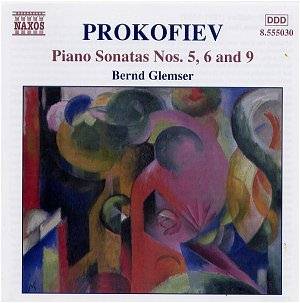This
was the first time I had encountered Bernd Glemser, a pupil of
the Russian, Vitaly Margulis. These Russian antecedents have given
Glemser a repertoire including Rachmaninov, Liszt, Tausig and
Prokofiev - composers of virtuoso Romantic school. He has won
seventeen international competitions since 1981 and has become
Germany’s youngest piano professor.
I
have to admit to not knowing these Prokofiev sonatas well but
I was captivated with his playing, although he does emphasise
the lyrical and romantic side of this music more than the percussive
and rhythmic.
In
preparing this review I looked briefly at Murray McLachlan’s complete
recording of the sonatas on Olympia also Barbara Nissman on Pierian
and Peter Dimitriew on Arte Nova. I must say that Glemser is genuinely
as interesting and perceptive as any of them and is recorded clearly
and naturally which can’t always be said of McLachlan.
Much
ink has been spilt on the subject of Prokofiev’s ‘War-time sonatas’
and his percussive use of the piano. Glemser is no wimp in the
violent faster music (listen to the finale of Number Six) but
his background and training enable him to play with a singing
tone which is also important in these works. Listen to the expressive
theme which acts as a second subject in the first movement of
the Sixth Sonata and which makes a necessary contrast. This same
sonata includes a Ravelian Waltz as its third movement which he
also plays with much grace. The same can be said of the Allegro
tranquillo opening of the Fifth Sonata.
But
now an important gripe. How did it come about that Naxos have
confused the order of the sonatas? Only on the back of the case,
not inside the booklet, are we told that the presented order is,
not unreasonably, Sonatas 5, 6 then 9 but the pieces are played
in the order 5, 9 and then 6. This becomes obvious once you read
Richard Whitehouse’s very descriptive booklet notes. To add to
the confusion the given timings are correct. So track six for
example does last 8.13 but it is not the third movement of the
sixth sonata but the third of the ninth. There are probably many
purchasers of this disc who will not read this who may well remain
in ignorance. How come the producer and engineer Jochen Gottschall
was not able to correct this before it was sent out.
As
for the music I will add that the Fifth Sonata is a typical ’twenties
work, classical, lyrical and elegant. It weighs in at just over
a quarter of an hour. The wartime Sixth Sonata which is twice
as long is an exciting and strong four movement work. The Ninth,
which follows a similar format is a much neglected piece. It is
beautiful and sensitive - even delicate at times, much liked by
Richter, and yet has some lively and virtuoso moments, especially
the fun fourth movement.
Gary
Higginson
